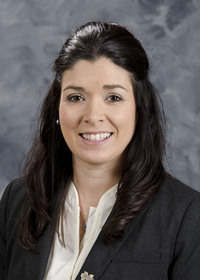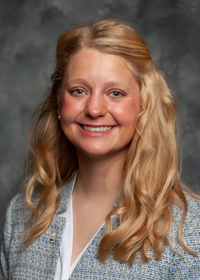Estimating Cattle Age Using Dentition
Knowing cattle age is useful for both cattle management and marketing. Age affects cattle value. Both replacement and market cows typically decline in value as they age. When possible, cattle birth records should be kept and transferred with the cattle as they move from one operation to another. In this way, the exact ages of animals will be known.
When cattle age records are not available, dentition may be used to estimate cattle age. It is common for cattle of unknown age to be “mouthed” by a veterinarian or other trained person to estimate their ages when marketed.
Dental Anatomy in Cattle
Dentition is the development of teeth within the mouth. A schematic of a bovine skull is shown in Figure 1 to depict the locations of the three major teeth types: incisors, premolars, and molars. The incisors appear toward the front of the mouth and only on the bottom jaw of cattle. The front of the upper jaw is a hard dental pad without teeth (see Figure 2). The premolars appear adjacent to the incisors on both sides and back toward the rear of the mouth. Moving farther toward the rear of the mouth, the molars appear adjacent to the premolars. The premolars and molars are collectively known as cheek teeth.


Cattle first develop 20 temporary teeth, known also as deciduous, milk, or baby teeth (Figure 3). These temporary teeth eventually fall out and are replaced with 32 permanent or adult teeth as an animal matures. Temporary teeth are easily distinguishable from permanent teeth. They are much smaller and whiter than permanent teeth. Temporary teeth are also more triangular in appearance than newly developed permanent teeth, although permanent teeth become more triangular over time. Figure 4 shows temporary teeth in the corner positions in comparison to permanent teeth in the intermediate and central incisor positions.


Cattle develop eight temporary incisors that are later replaced with eight permanent incisors. Figure 5 illustrates the names and locations of each of the four pairs of incisors. The central pair is called the pinchers. Immediately next to the pinchers, the second pair of incisors to develop is referred to as the first intermediates or laterals. The third pair of incisors is also known as intermediates or laterals. They develop next to the previous pair of intermediate incisors. The final pair of incisors develops to the outer sides of the previously erupted incisors. This fourth pair of incisors is called the corners.
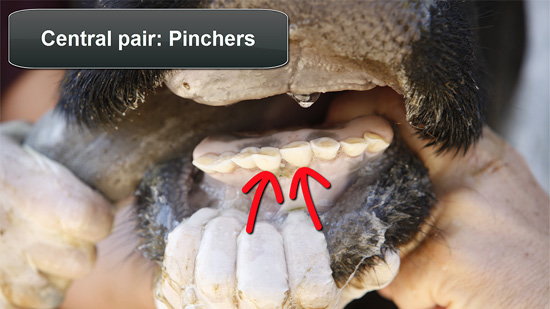
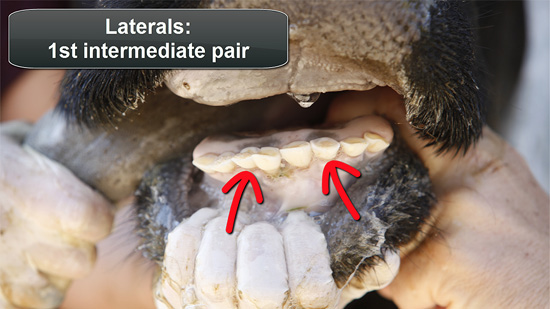
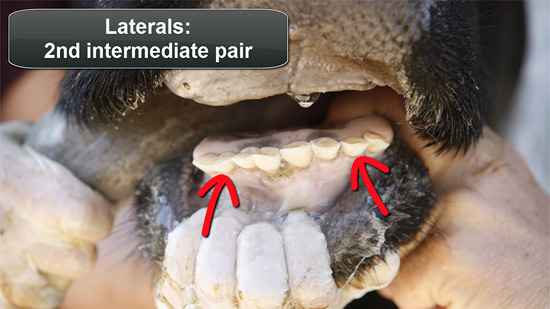
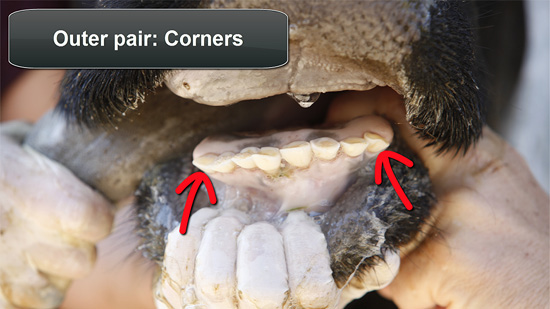

Among the temporary teeth, there are twelve premolars, three on each side of the upper and three on each side of the lower jaws. Similarly, mature cattle have twelve permanent premolars. There are no temporary molars, only permanent molars. As with the permanent premolars, cattle develop twelve permanent molars. Three permanent molars appear on each side of the upper, and another three molars appear on each side of the lower jaws.
|
Teeth |
Eruption |
Full development |
Wear |
|---|---|---|---|
|
Pinchers |
18 to 24 months |
24 months |
Leveled at 5 to 6 years, noticeable wear at 7 to 8 years |
|
1st intermediate pair |
24 to 30 months |
36 months |
Leveled at 6 to 7 years, noticeable wear at 8 to 9 years |
|
2nd intermediate pair |
36 months |
48 months |
Leveled at 7 to 8 years, noticeable wear at 9 to 10 years |
|
Corners |
42 to 48 months |
60 months |
Leveled at 9 years, noticeable wear at 10 years |
|
Teeth |
Eruption |
|---|---|
|
1st cheek tooth pair |
24 to 30 months |
|
2nd cheek tooth pair |
18 to 30 months |
|
3rd cheek tooth pair |
30 to 36 months |
|
Teeth |
Eruption |
|---|---|
|
4th cheek tooth pair |
5 to 6 months |
|
5th cheek tooth pair |
12 to 18 months |
|
6th cheek tooth pair |
24 to 30 months |
Tooth Development and Wear
Incisor eruption occurs in a distinct pattern over time and provides information about the approximate age of an animal. At birth, a calf typically has two or more temporary incisors erupted through its gums, although some calves are born without any incisors visible. Temporary incisor eruption occurs rapidly in the newborn calf. By the time a calf is a month old, all eight temporary incisors generally appear.
The eruption, development, and wear patterns common for permanent teeth in cattle are detailed in Table 1. The permanent pinchers appear at 18 to 24 months of age and are fully developed in two-year-old cattle (Figure 6). They are followed by the appearance of the first intermediate pair of incisors at 24 to 30 months of age. Full development of the first intermediate pair of permanent incisors happens by the time an animal is three years old. The second permanent intermediate incisor pair erupts when an animal is around three years old, with full development occurring at four years of age. The last set of permanent incisors to erupt are the corners, which debut at 42 to 48 months of age and are fully developed by the time an animal turns five years old. The eruptions of all the permanent cheek teeth take place in the first three years of an animal’s life.
In general, the permanent pinchers become leveled in cattle between the ages of five and six years. They commonly show noticeable wear by the time cattle reach seven to eight years of age. The first and second permanent intermediate incisor pairs level at six to seven and seven to eight years of age, respectively. Noticeable wear is evident in these lateral pairs by the time cattle are eight to ten years old. The corners normally level in nine-year-old cattle and show obvious wear in ten-year-olds.
Age determination of cattle up to five years based on incisor eruption and development is more accurate than age estimation based on dental wear for older cattle. Accelerated tooth wear sometimes occurs and lessens the accuracy of age estimation based on dentition. As such, evaluation of tooth wear provides general age information, but dentition varies among cattle based on their diets. Relatively coarse or gritty feedstuffs in cattle diets accelerate tooth wear. For example, native forages grown on rangeland, as commonly found in the western United States, may be coarser in texture and cause more rapid tooth wear in grazing cattle than improved forages grown on pastureland, as is common in the southeastern states.

In addition, individual cattle genetics can impact their susceptibility to tooth wear and loss. Crossbred cattle often maintain their incisors longer than straightbred cattle. Similarly, crossbred cattle with Bos indicus (Brahman) bloodlines typically keep their incisors longer than crossbred cattle with only Bos taurus (British or Continental breeds) bloodlines. To adapt these general age guidelines to the local conditions, compare to the dentition of cattle of known age under those conditions. Modify the guidelines to fit the cattle and their environment.

The necks of teeth near their bases become narrower as teeth wear (Figure 7). Gaps begin to appear and widen between teeth, and teeth take on a more triangular shape above the gum surface. As tooth wear continues, the roots of teeth may become exposed (Figure 8). Teeth may loosen in their sockets and later fall out of the mouth entirely. Cattle with broken or missing teeth are called “broken-mouth” cattle (Figure 9).
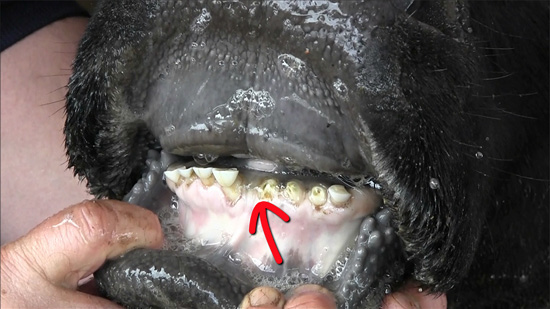
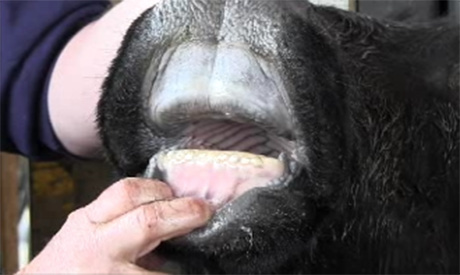
Another noticeable aspect of tooth wear is that the initial arch of a tooth eventually flattens with wear. Teeth wear down over time toward their bases at the gum line. A “short-mouth” animal has experienced significant tooth wear. Its teeth are noticeably shorter and smoother than before but are not yet worn down to the gum line. It is reasonable to assume that a “short-mouth” cow is eight years or older. Extreme wear finally results in very short tooth stumps known as “peg teeth.” In a “smooth-mouth” animal, all of the incisors are either missing or worn down smooth to the gums (Figure 10). A cow in this condition is referred to as being a “gummer.”
Another indication of tooth wear is the loss of enamel and exposure of dentin. Enamel is the hard, white outer protective coat of a tooth. Dentin is the soft inner core of a tooth. It is much darker than enamel, often appearing in varying shades of yellow. Dentin becomes more apparent as tooth wear progresses. “Dental star” is a term used to describe the dentin that appears at the biting or chewing surface of a tooth as it wears. Dentin appears as a circular or star-like shape surrounded by enamel. Dental stars typically appear in the pinchers and intermediate incisors in cattle around 10 to 12 years of age. The corners show dental stars at 13 years of age. As with other aspects of tooth wear, these age estimates based on visible dentin are only general guidelines and vary depending on the individual animal and its environment.
Dentition Affects Cattle Value and Productivity
Routinely examine cattle teeth to identify serious dental problems. Bad teeth are among the most common reasons cows are culled. Poor-mouthed cattle may require treatment or diet modifications to remain productive; otherwise, they need to be marketed for harvest.
Without proper dentition, an animal may not be capable of consuming adequate nutrients to maintain acceptable body condition or weight. Broken, missing, or heavily worn teeth may cause an animal to excessively dribble feed from its mouth or to have difficulty harvesting forage during grazing or grinding forage during rumination. Dental problems that affect forage and feed consumption may be the cause of rapid body condition and weight loss relative to other cattle in the herd.
A “solid-mouth” animal has no broken or missing teeth. “Solid-mouth” may also refer to a lack of noticeable gaps between teeth. Solid-mouth cattle generally have more value than comparable cattle with more advanced dental wear. This is because cattle with better overall dentition are expected to have a longer remaining productive life.
Handling Cattle for Teeth Inspection
When inspecting an animal’s teeth, use proper cattle restraint and handling procedures. Injuries can result from sudden head movement if animals are not handled carefully. Start by restraining the head in a head catch. It may be useful to further restrain the head with a mechanical device attached to the head catch that extends the animal’s neck to the side or to use a halter to secure the animal’s head. If nose tongs are applied, use caution in case they suddenly slip out of the animal’s nose.
Pry the mouth open by placing one or more fingers inside the corner of the mouth behind the teeth. Then grab the animal’s tongue and pull it to one side to hold the mouth open. This will minimize the risk of being bitten. Becoming efficient at visually appraising an animal’s teeth will help reduce the amount of time an animal must be restrained with its mouth open.
Additional Information
A video showing the process of estimating cattle age using dentition is available on the MSUBeefCattle YouTube channel. For more information on this or other beef cattle production topics, contact an office of the Mississippi State University Extension Service.
References
Food Safety Inspection Service. 2013. Using dentition to age cattle. U.S. Department of Agriculture, Washington, D.C. on May 1, 2013.
National Animal Health Monitoring System. 2010. Beef 2007-09. Part IV: Reference of beef cow-calf management practices in the United States, 2007-08. U.S. Department of Agriculture, Washington, D.C.
Pace, J. E., and D. L. Wakeman. 2003. Determining the age of cattle by their teeth. CIR253. Florida Cooperative Extension Service, Institute of Food and Agricultural Sciences. University of Florida, Gainesville, FL.
Thrift, F. A., and T. A. Thrift. 2003. Review: Longevity attributes of Bos indicus x Bos taurus crossbred cows. Prof. Anim. Sci. 19:329-341.
Torrell, R. 1998. Methods of determining age in cattle. Cattle Producer’s Library: CL712. University of Nevada, Reno, NV.
Troxel, T. R., M. S. Gadberry, S. Cline, J. Foley, G. Ford, D. Urell, and R. Wiedower. 2002. Factors affecting the selling price of replacement and market cows sold at Arkansas livestock auctions. Prof. Anim. Sci. 18:380-386.
U.S. Department of Agriculture. 1898. Determination of age by teeth in domestic animals. In: Yearbook of the United States Department of Agriculture: 1898. Page 667. Washington, D.C.
The information given here is for educational purposes only. References to commercial products, trade names, or suppliers are made with the understanding that no endorsement is implied and that no discrimination against other products or suppliers is intended.
Publication 2779 (POD-07-22)
Revised by Brandi Karisch, PhD, Associate Extension/Research Professor, Animal and Dairy Sciences; from an earlier version by Jane A. Parish, PhD, Professor and Head, North Mississippi Research and Extension Center.
The Mississippi State University Extension Service is working to ensure all web content is accessible to all users. If you need assistance accessing any of our content, please email the webteam or call 662-325-2262.



